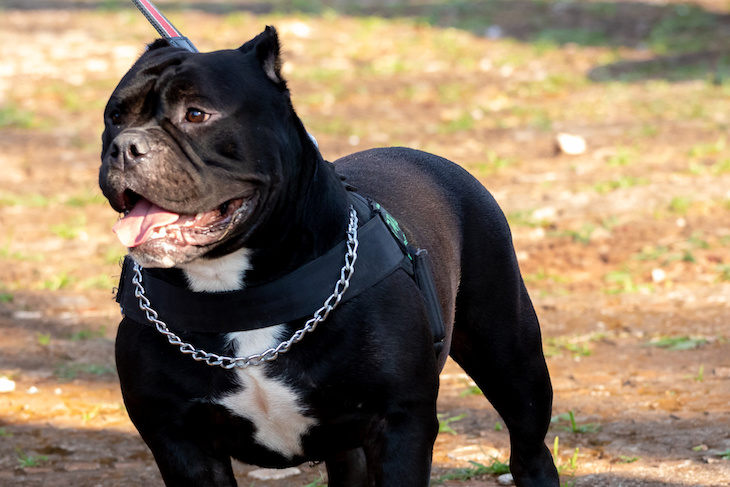Three people including an 11-year-old girl have been mauled by an American Bully XL dog in Birmingham. The video showing the attack, which took place on Saturday is horrific: the child is bitten as she lays helplessly on the ground. The dog then turns on two men who intervene, dragging one to the ground before going for his head and neck. It was a miracle no one was killed.
For too long, the government – which has the power to ban these violent and horrible dogs – has sat on its hands. Now, though, it might finally be waking up to the threat. Suella Braverman is seeking ‘urgent advice’ on banning the Bully XL. The Home Secretary’s intervention comes amid mounting public concern about these dogs that have been causing carnage across the country. Since 2021 there have been at least 11 deaths caused by XLs, as well as countless attacks. The Met Police are seizing record numbers of dogs, some of which are being bred by ‘backyard’ breeders. A recent YouGov poll revealed that 57 per cent of people are now in favour of a ban, and only 17 per cent against.
Yet despite Braverman’s call for action, there is no certainty that any ban will actually be implemented. Leading dog welfare charities, including the RSPCA and Dogs Trust, the Kennel Club and the British Veterinary Association, oppose breed specific legislation. Sam Gaines, spokesperson for the RSPCA, has said: ‘There is no specific research to demonstrate that selection for fighting results in dogs that are more aggressive towards people than other dogs.’
This sentiment, of course, is little comfort to those who have been mauled by an Bully XL. Jack Lis, a ten-year-old boy, was killed in Wales in 2021 by a Bully XL. The image of that dog, named Beast, which weighed 96.5lbs (43.7kg), is terrifying. How can organisations like the RSPCA continue to bury their heads in the sand about the threat posed by such creatures?
How can organisations like the RSPCA continue to bury their heads in the sand?
The Tories are also guilty of not acting quickly. Environment Minister Lord Benyon announced last month that the government had ‘no plans’ to add the Bully XL to the banned list but was ensuring the existing powers and legal framework for dog control were being properly applied.
Again, this sounds good, but the Bully XL is different from ordinary dogs, both physically and mentally. Selective breeding over centuries, first for bull and bear baiting, then for dog fighting, created the ultimate canine killer, one that can even see its own species as prey. When an XL grabs hold of a small dog, it thrashes it about in its jaws like a ragdoll, often breaking its neck or causing extreme internal damage.
When Bully XLs attack people, they go for limbs or the throat – as the dog in Birmingham did – and once they’ve got a grip on someone it’s almost impossible to get them to release their powerful jaws. This is why, when the Bully attacks, the result can so easily be fatal.
Even XLs that are under control pose a risk: if you have the misfortune of walking past one on the street, all too often you see that they are straining on their leads. Even for a strong man, they are clearly difficult to control. When they go into attack mode, people get pulled over and dragged along the ground. Once they smell blood, it can be very hard – even impossible – for an owner to regain control. A child doesn’t stand a chance.
Organisations like the RSPCA continue to stick to their guns. But a fightback against the ‘blame the deed, not the breed’ viewpoint has been gathering momentum. The Campaign for Evidence-Based Regulation of Dangerous Dogs (CEBRDD) has joined forces with Protect Our Pets, which supports those who have lost pets to killer dogs, and Bully Watch UK. Both are calling for the XL to be banned.
Pitbull-types have been banned in Britain for three decades and as a result we have seen very low fatalities. However, the introduction of the American Bully XL has seen deaths skyrocket. The government must act now and ban the American Bully XL before more children – and more dogs – face attacks, maulings and death.
Bully Watch – which is made up of dog lovers – describes itself as an anonymous group of professionals who are devoting their time to providing an alternative viewpoint. ‘We started digging behind the science and data of dangerous dog attacks and found it differed widely with the narrative being pushed by some animal welfare organisations,’ a spokesman for the group told me.
‘We’re finding cases where these dogs were looked after and still killed another pet dog or bit someone or turned on their owners.’
Defenders of Bully XLs sometimes claim that no type of dog is any more dangerous than another, pointing to academic ‘research’ that proves this is so. They appear to believe genes play no part in a dog’s behaviour and their answer to the ‘dog bite’ problem is more education and training. This position is untenable.
Jack Lis was so badly mauled by an XL he could only be identified by his shoe. A dog capable of such savagery is far too dangerous to be kept as a pet. The truth about these dogs can no longer be denied. Let’s hope the Home Secretary isn’t all words and no action. These dogs, and their crosses, need to be banned.
Got something to add? Join the discussion and comment below.
Get 10 issues for just $10
Subscribe to The Spectator Australia today for the next 10 magazine issues, plus full online access, for just $10.




















Comments
Don't miss out
Join the conversation with other Spectator Australia readers. Subscribe to leave a comment.
SUBSCRIBEAlready a subscriber? Log in